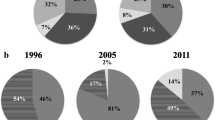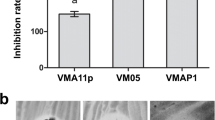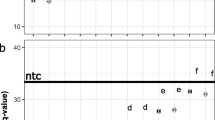Abstract
Rhizomania of sugar beet caused by the Beet necrotic yellow vein virus (BNYVV) and transmitted by Polymyxa betae leads to great losses of yield in sugar beet production worldwide. The virus is multiplying in the sugar beet and its roots are finally enclosed in P. betae sporosori and released into the soil during decomposing. Virus and vector sporosori remain infectious in the soil for years. Setting free sporosori und BNYVV into the environment during sugar production and deposing of contaminated waste implies a phytosanitary risk for spreading rhizomania. Fermentation of plant residues in biogas plants could possibly lead to inactivation of P. betae and/or BNYVV. Within a research project, conducted at the Bavarian State Research Center for Agriculture (LfL), the persistence of different pathogens — including P. betae and BNYVV — during biogas fermentation was studied to evaluate the hygienisation potential of the biogas process and to assess the risk of spreading pathogens with the fermentation residues. To investigate BNYVV tenacity, infected rootlets of sugar beet plantlets were incubated at 38°C and 55°C in 36 l-continuous fermenters up to 36 days and analyzed by ELISA directly after fermentation. In addition, to check the infectivity of the vector/virus complex a bioassay was performed. When fermented at 38°C, BNYVV could be detected by ELISA in the rootlets for up to 36 days, but only during the first 4–8 days of incubation infectivity of virus and/or vector were retained. Compared with incubation at 38°C, incubation at 55°C led to an enhanced degradation of BNYVV and accelerated loss of viral and/or vector infectivity: BNYVV antigen concentration was dramatically reduced and reached a minimum after 3 weeks of incubation. Viral and/or vector infectivity were lost very fast already during the first 4 days of incubation in the fermenter. It can be assumed that biogas fermentation under thermophilic but also mesophilic conditions leads to a relatively fast inactivation of BNYVV and/or its vector P. betae. At least with respect to rhizomania, widely harmless fermentation residues should be produced if the retention time in the fermenter at temperatures between 38°C and 55°C is at least 1 week. But nevertheless, for a full assessment of the phytosanitary risk additional studies are required.
Zusammenfassung
Die Rizomania der Zuckerrübe, die durch das Beet necrotic yellow vein virus (BNYVV) (Rübenwurzelbärtigkeits-Virus) verursacht und durch den Vektor Polymyxa betae übertragen wird, führt weltweit zu großen Ertragsverlusten. Das Virus, das sich im Rübenkörper und in den Wurzeln vermehrt, gelangt eingeschlossen in P. betae-Sporosori über Pflanzenreste in den Boden. Das Virus und die Sporosori des Vektors können auf den Kulturflächen jahrelang infektiös bleiben. Werden Sporosori und BNYVV während der Zuckerproduktion und bei der Entsorgung kontaminierter Abfälle in die Umwelt freigesetzt, so ergibt sich auch daraus ein phytosanitäres Risiko für die Verbreitung der Rizomania. Eine Möglichkeit der Inaktivierung des Vektors und/oder des BNYVV könnte die Vergärung des Pflanzenmaterials in Biogasanlagen sein. In einem Forschungsprojekt, durchgeführt an der Bayerischen Landesanstalt für Landwirtschaft (LfL), wurde die Persistenz verschiedener Phytopathogene — einschließlich P. betae und BNYVV — während der Biogasfermentation untersucht, um das Hygienisierungspotential des Biogasprozesses und das Risiko einer Verschleppung von Pathogenen mit dem Gärrest abzuschätzen. Um das überdauerungsvermögen des BNYVV zu analysieren, wurden infizierte Zuckerrübenwurzeln bei 38°C und 55°C in 36 l-Durchflussfermentern über einen Zeitraum von bis zu 36 Tagen inkubiert und direkt nach der Inkubation mittels ELISA getestet. Zusätzlich wurde zur überprüfung der Infektiosität des Vektors bzw. Virus ein Biotest durchgeführt. BNYVV konnte nach Inkubation im Fermenter bei 38°C bis zum Versuchsende am 36. Tag in den Wurzeln mittels ELISA nachgewiesen werden, aber nur während der ersten 4–8 Tage der Inkubation blieb die Infektiosität des Virus und/oder Vektors erhalten. Im Vergleich zur Fermentation bei 38°C führte eine Inkubation bei 55°C zu einem beschleunigten Abbau von BNYVV und einer rascheren Inaktivierung des Virus und/oder Vektors: Die Konzentration an BNYVV-Antigenen wurde dramatisch reduziert und erreichte nach 3-wöchiger Inkubation ein Minimum, die Virulenz ging rasch bereits während der ersten 4 Tage der Inkubation im Fermenter verloren. Man kann davon ausgehen, dass die Biogasfermentation unter thermophilen, aber auch unter mesophilen Bedingungen zu einer relativ schnellen Inaktivierung des BNYVV und/oder seines Vektors P. betae führt. Zumindest bezüglich Rizomania sollten weitgehend unbedenkliche Gärreste gewonnen werden, wenn die Verweildauer des Substrats im Biogasfermenter bei Temperaturen zwischen 38°C und 55°C mindestens eine Woche beträgt. Dennoch sind zur vollständigen Abschätzung des phytohygienischen Risikos weitere Studien notwendig.
Similar content being viewed by others
References
Abe, H., 1987: Studies on the ecology and control of Polymyxa betae Keskin, as a fungal vector of the causal virus (Beet necrotic yellow vein virus) of rhizomania disease of sugar beet. Rep. Hokkaido Prefect. Agric. Exp. Stn. 60, 1–99.
Aguilar, M.I., M.L. Guirado, J.M. Melero-Vara, J. Gómez, 2010: Efficacy of composting infected plant residues in reducing the viability of Pepper mild mottle virus, Melon necrotic spot virus and its vector, the soil-borne fungus Olpidium bornavanus. Crop Prot. 29, 342–348.
Anonymous, 1977: Composition and structure of Beet necrotic yellow vein virus. J. Gen. Virol. 35, 397–401.
Anonymous, 2007: Biogashandbuch Bayern — Materialienband — Kap. 1.1 — 1.5, Bayerisches Landesamt für Umwelt, Augsburg, Germany. http://www.lfu.bayern.de/abfall/fachinformationen/biogashandbuch/index.htm, May 2010.
Bollen, G.J., D. Volker, 1996: Phytohygienic aspects of composting. In: de Bertoldi, M., P. Sequi, B. Lemmes, T. Papi: The Science of Composting 1, 223–246. Blackie Academic & Professional, London, United Kingdom.
Ciafardini, G., 1991: Evaluation of Polymyxa betae Keskin contaminated by Beet necrotic yellow vein virus in Soil. Appl. Environ. Microbiol. 57, 1817–1821.
Dickens, J.W., P. Reed, A. Wright, 1991: Investigation of the survival of Polymyxa betae during vegetable processing. Sugar Beet Research & Education Committee Report: Rhizomania and Beet mild yellowing virus studies 1991: Committee Paper No. 2526.
Frauz, B., U. Weinmann, H. Oechsner, W. Drochner, 2006: Chances of a dual use in biogas processes: Deactivation of Fusarium spores throughout fermentation processes in biogas plants and simultaneous energy production. 34. Symposium “Actual Tasks on Agricultural Engineering”, Opatija, Croatia, 141–148.
Friedrich, R., D. Kaemmerer, P. Büttner, L. Seigner, 2009: Evaluierung des Hygienisierungspotenzials des Biogasprozesses im Hinblick auf phytopathogene Schaderreger. In: Internationale Wissenschaftstagung Biogas Science 2009, Erding 02.–04.12.09, ISSN 1611-4159, Tagungsband 2, 255–266.
Friedrich, R., D. Kaemmerer, L. Seigner, 2010: Manche Erreger bleiben lange vital. Bayerisches Landwirtschaftliches Wochenblatt 18, 28–31.
Koenig, R., S. Loss, J. Specht, M. Varrelmann, P. Lüddecke, G. Deml, 2009: A single U/C nucleotide substitution changing alanine to valine in the Beet necrotic yellow vein virus P25 protein promotes increased virus accumulation in roots of mechanically inoculated, partially resistant sugar beet seedlings. J. Gen. Virol. 90, 759–763.
Keskin, B., 1964: Polymyxa betae n.sp., ein Parasit in den Wurzeln von Beta vulgaris Tournefort, besonders während der Jugendentwicklung der Zuckerrübe. Arch. Mikrobiol. 49, 348–374.
Kingsnorth, C.S., M.J.C. Asher, G.J.P. Keane, D.M. Chwarszczynska, M.C. Luterbacher, E.S. Mutasa-Göttgens, 2003: Development of a recombinant antibody ELISA test for the detection of Polymyxa betae and its use in resistance screening. Plant Pathol. 52, 673–680.
Nishinome, Y., M. Shimizu, S. Takakura, J. Soma, H. Abe, 1996: Disinfection of beet sugar factory waste soil in the process of composting. Proc. Japan. Soc. Sugar Beet Technol. 38, 150–159.
Röhling, I., U. Keymer, 2007: Biogasanlagen in Bayern 2006: Ergebnisse einer Umfrage. LfL-Information, Bayer. Landesanstalt für Landwirtschaft, http://www.lfl.bayern.de/publikationen/daten/informationen/p_26925.pdf, May 2010.
Scholten, O.E., W. Lange, 2000: Breeding for resistance to rhizomania in sugar beet: A review. Euphytica 112, 219–231.
Stacey, A.J., J.E. Truscott, M.J.C. Asher, C.A. Gilligan, 2004: A model for the invasion and spread of rhizomania in the United Kingdom: Implications for disease control strategies. Phytopathology 94, 209–215.
Tamada, T., 1975: Beet necrotic yellow vein virus. CMI/AAB Descriptions of Plant Viruses 144.
Termorshuizen, A.J., D. Volker, W.J. Blok, E. Ten Brummeler, B.J. Hartog, J.D. Janse, W. Knol, M. Wenneker, 2003: Survival of human and plant pathogens during anaerobic mesophilic digestion of vegetable, fruit and garden waste. Eur. J. Soil Biol. 39, 165–171.
Turner, J., D.A. Stafford, D.E. Hughes, J. Clarkson, 1983: The reduction of three plant pathogens (Fusarium, Corynebacterium and Globodera) in anaerobic digesters. Agr. Wastes 6, 1–11.
Van Rijn, E., A.J. Termorshuizen, 2007: Eradication of Polymyxa betae by thermal and anaerobic conditions and in the presence of compost leachate. J. Phytopathol. 155, 544–548.
Author information
Authors and Affiliations
Corresponding author
Rights and permissions
About this article
Cite this article
Friedrich, R., Kaemmerer, D. & Seigner, L. Investigation of the persistence of Beet necrotic yellow vein virus in rootlets of sugar beet during biogas fermentation. J Plant Dis Prot 117, 150–155 (2010). https://doi.org/10.1007/BF03356352
Received:
Accepted:
Published:
Issue Date:
DOI: https://doi.org/10.1007/BF03356352




